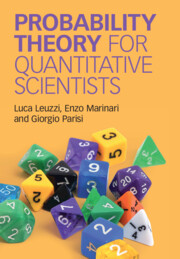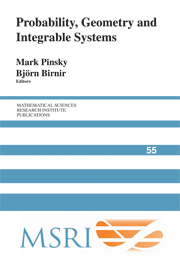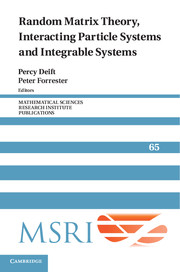Refine search
Actions for selected content:
3044 results in Probability theory and stochastic processes
9 - Recurrent Events
-
- Book:
- Probability Theory for Quantitative Scientists
- Published online:
- 24 July 2025
- Print publication:
- 14 August 2025, pp 230-248
-
- Chapter
- Export citation
12 - Correlated Events
-
- Book:
- Probability Theory for Quantitative Scientists
- Published online:
- 24 July 2025
- Print publication:
- 14 August 2025, pp 304-334
-
- Chapter
- Export citation
2 - Probability Distributions
-
- Book:
- Probability Theory for Quantitative Scientists
- Published online:
- 24 July 2025
- Print publication:
- 14 August 2025, pp 23-42
-
- Chapter
- Export citation
11 - Numerical Simulations
-
- Book:
- Probability Theory for Quantitative Scientists
- Published online:
- 24 July 2025
- Print publication:
- 14 August 2025, pp 289-303
-
- Chapter
- Export citation

Probability Theory for Quantitative Scientists
-
- Published online:
- 24 July 2025
- Print publication:
- 14 August 2025

Probability, Geometry and Integrable Systems
-
- Published online:
- 27 June 2025
- Print publication:
- 17 March 2008

Random Matrix Theory, Interacting Particle Systems, and Integrable Systems
-
- Published online:
- 29 May 2025
- Print publication:
- 15 December 2014
6 - Asymptotics for Renewal Measure for Transient Markov Chain via Martingale Approach
-
- Book:
- Markov Chains with Asymptotically Zero Drift
- Published online:
- 24 April 2025
- Print publication:
- 08 May 2025, pp 191-220
-
- Chapter
- Export citation
Preface
-
- Book:
- Markov Chains with Asymptotically Zero Drift
- Published online:
- 24 April 2025
- Print publication:
- 08 May 2025, pp ix-xii
-
- Chapter
- Export citation
Subject Index
-
- Book:
- Markov Chains with Asymptotically Zero Drift
- Published online:
- 24 April 2025
- Print publication:
- 08 May 2025, pp 410-412
-
- Chapter
- Export citation
3 - Down-Crossing Probabilities for Transient Markov Chain
-
- Book:
- Markov Chains with Asymptotically Zero Drift
- Published online:
- 24 April 2025
- Print publication:
- 08 May 2025, pp 88-109
-
- Chapter
- Export citation
9 - Tail Analysis for Positive Recurrent Markov Chains with Drift Going to Zero More Slowly Than 1/x
-
- Book:
- Markov Chains with Asymptotically Zero Drift
- Published online:
- 24 April 2025
- Print publication:
- 08 May 2025, pp 281-305
-
- Chapter
- Export citation
11 - Applications
-
- Book:
- Markov Chains with Asymptotically Zero Drift
- Published online:
- 24 April 2025
- Print publication:
- 08 May 2025, pp 339-399
-
- Chapter
- Export citation
Notation and Conventions
-
- Book:
- Markov Chains with Asymptotically Zero Drift
- Published online:
- 24 April 2025
- Print publication:
- 08 May 2025, pp xiii-xvi
-
- Chapter
- Export citation
8 - Tail Analysis for Recurrent Markov Chains with Drift Proportional to 1/x
-
- Book:
- Markov Chains with Asymptotically Zero Drift
- Published online:
- 24 April 2025
- Print publication:
- 08 May 2025, pp 236-280
-
- Chapter
- Export citation
Author Index
-
- Book:
- Markov Chains with Asymptotically Zero Drift
- Published online:
- 24 April 2025
- Print publication:
- 08 May 2025, pp 408-409
-
- Chapter
- Export citation
1 - Introduction
-
- Book:
- Markov Chains with Asymptotically Zero Drift
- Published online:
- 24 April 2025
- Print publication:
- 08 May 2025, pp 1-40
-
- Chapter
- Export citation
4 - Limit Theorems for Transient and Null Recurrent Markov Chains with Drift Proportional to 1/x
-
- Book:
- Markov Chains with Asymptotically Zero Drift
- Published online:
- 24 April 2025
- Print publication:
- 08 May 2025, pp 110-153
-
- Chapter
- Export citation
Frontmatter
-
- Book:
- Markov Chains with Asymptotically Zero Drift
- Published online:
- 24 April 2025
- Print publication:
- 08 May 2025, pp i-iv
-
- Chapter
- Export citation
10 - Markov Chains with Asymptotically Non-Zero Drift in Cramér Case
-
- Book:
- Markov Chains with Asymptotically Zero Drift
- Published online:
- 24 April 2025
- Print publication:
- 08 May 2025, pp 306-338
-
- Chapter
- Export citation
